In the previous pages, we reviewed the wondrous features of the honeybee. We saw how the bee colony constructs the great architectural wonder of the hive, the intricate and subtle plans they employ while constructing it, and the jobs they automatically perform,d which are quite hard even for men.
As mentioned previously, bees are able to do this extraordinarily hard work not because they are cleverer than men, but because they are "inspired" so. Otherwise, it would not be possible for thousands of unconscious animals to accomplish such a hard and complicated operation, which needs control and supervision from one centre.
However, bees are not the only excellent architects in nature. In the following pages, we will look at other animals, which very skilfully overcome very complicated and difficult "construction" works, as difficult as that of the bees. These animals, just like the bees, use the knowledge "inspired" in them and construct architectural wonders by the help of some interesting qualities given to them at their creation.
 |
Beavers are the first among the excellent architects in nature that come to mind. These animals build their lodges in stationary ponds, but these ponds are special in being artificially formed by dams beavers build over the stream.
The beaver is full of special design characteristics for the construction work it performs.
The most important tools of the animal are its teeth. It constructs dams with branches that it has nibbled and cut down. Naturally, its teeth frequently wear away, erode and break. Had it not been especially equipped with a special system for this work, it would shortly lose its teeth and die from starvation.
However, as we have mentioned, the problem of the animal has been settled from the very start. Its four front teeth, which it uses for nibbling trees, continue to grow throughout its life.
How have the teeth gained such a feature? Did the beaver decide to grow them after seeing its teeth break? Did the teeth of the beaver that constructed the first dam suddenly begin to grow? Apparently, the animal has been created possessing such a feature. That this is a special creation can be sensed from the fact that the size of the back teeth stays constant. If all the teeth of the animal had kept growing, the back teeth that are not worn away would grow excessively, force the jaw of the animal and make its mouth unusable. However, only the four teeth at the front grow, i.e., the ones it uses for nibbling trees.
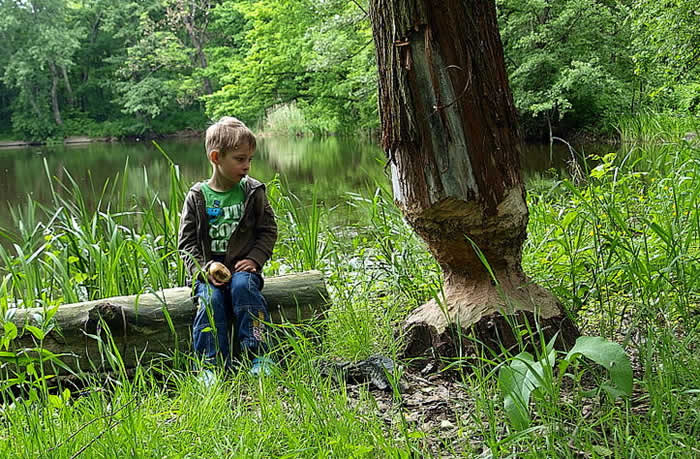 |
In addition to its teeth, many other organs of the beaver are especially created in compliance with the work it does. It has transparent curtains that prevent the eye from being damaged while working under water, special valves to prevent water from entering its nose and ears, broad back feet enabling it to move like a fish under water, and a flat, wide and hard tail. These are some distinctive features the animal possesses from its creation.
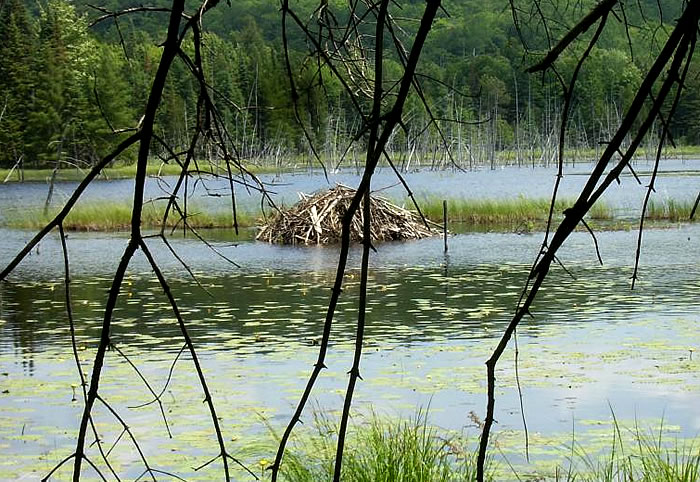 |
Beavers set about building a dam in order to block the stream and form a stationary pond in which they can build a lodge for themselves. For this purpose, they first push thick branches down into the stream-bed. Then they heap up relatively thinner ones over those heavier ones. They are yet faced with the problem that the running water might take this mass of branches away. Unless the dam is clamped tight to the streambed, the running water would soon damage the dam. The best thing to do to prevent the dam from being ruined by the water is to drive stakes into the streambed and to build the dam on these stakes. For this reason, beavers use large stakes as main buttresses when they build their dam. They, however, do not bother to drive these stakes into the streambed, but fix these stakes in the water by weighing them down with stones. Lastly, they fasten the branches they have piled up with a special mortar they make from clay and dead leaves. This mortar is water-resistant and is very firm against the corrosive effect of water.
 |
The dam built by beavers blocks the water at an angle of exactly 45o. This means that the animal does not build its dam by throwing branches in the water at random, but in a carefully planned manner. What deserves attention here is that all modern hydro-electrical power stations are built at the same angle today. In addition, beavers do not make the mistake of completely blocking the water. They build the dam in such a way that it keeps the water at the desired level and leaves special canals for excess water to run through.
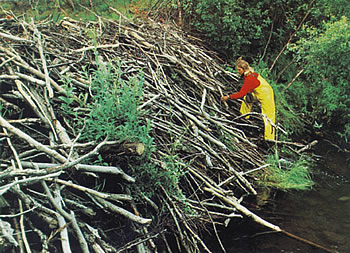 |
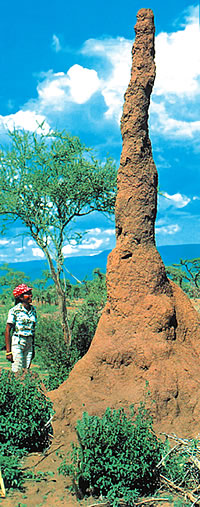 |
The role of termites among the architects of nature is indisputable. Termites, which look very much like ants, live in imposing nests they make out of soil. The height of these nests reach up to 6 m, and their width up to 12 m. The most interesting thing is that these animals are blind.
The construction material of the nest is a hard resistant mortar which workers make by blending their saliva with soil. The most extraordinary aspect of the construction art of termites is that they provide continuous air to the colony and keep the heat and moisture amazingly constant. The hard and thick walls of the towers they make from soil seclude the inner part of the nest from the heat outside. For air circulation, they make special corridors along the inner walls of the nest. On the other hand, pores continuously filter the air.
For the oxygen needed by the inhabitants of a middle-sized nest, 1,500 litres of air are required every day. If this air were taken directly into the nest, the temperature of the nest would rise to a level that would be extremely risky for termites. However, they have taken precautions against this as if they knew what would later befall them.
They make damp cellars under the nest as a protection against excessive heat. Species living in the Sahara dig an irrigation canal 40 m underground and provide that water reaches the nest by evaporation. The thick walls of the tower help maintain interior humidity.
Temperature control, just like humidity control, is done in a very sensible and sensitive manner. The air outside passes through thin corridors lying on the surface of the nest, enters moist cellars and reaches a hall at the top of the nest; there, air warms by contacting the bodies of insects and rises. Thus, an air circulation system, which is continuously inspected by colony workers, is provided by way of simple physical principles.
Outside the nest, a roof - which is sloped as a protection against floods - and gutters strike the eye.
How do these living beings, with brains smaller than a cubic millimetre and devoid of the sense of sight, accomplish such a complex construction?
The work of termites certainly is the outcome of collective work among those creatures. Saying that "the insects dig independent tunnels and these happen to be in accord with each other" would be sheer nonsense. At this point, however, we face a question: how do these animals work in harmony while performing this complex job? We all know that when such a construction is made by men, beforehand the construction is drawn by an architect, then the plans are distributed to the workers, and all the construction is organised in a work site. How could termites, which have no such communication among them, and which are, after all, blind, manage to make this giant construction in harmony?
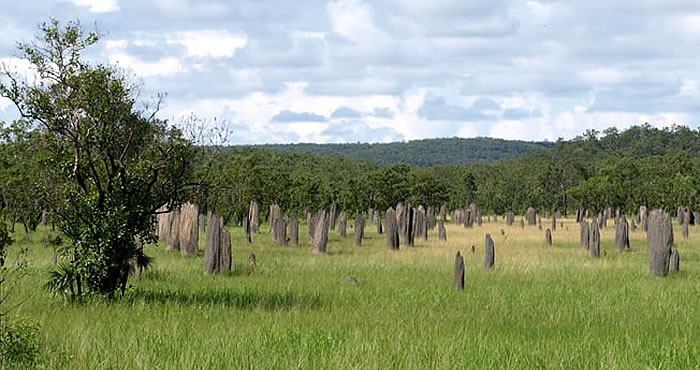 |
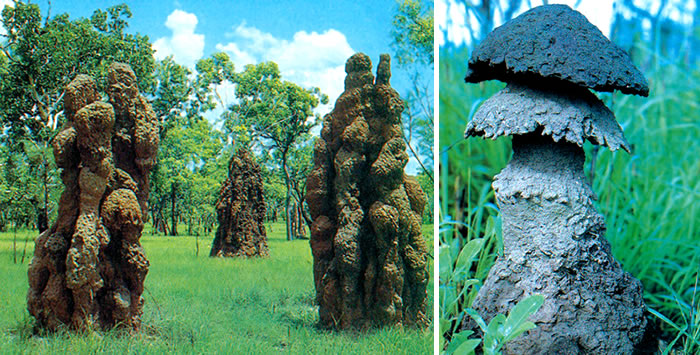 |
| Being no taller than a few centimetres, termites can erect towers many meters high without using any tools. This admirable nest perfectly protects the inhabitant termite colony with a population of over a million from their enemies and unfavourable external life conditions. |
An experiment on the issue helps us find the answer to this question.
In the experiment, as a first step, a termite nest that was already in construction was split into two. Throughout the construction, the two termite groups were prevented from contacting one another. The result was surprising. What finally came to sight were not two separate nests, but two pieces of one nest. When the pieces were brought together, it was observed that all the corridors and canals fitted one another.
How can this be explained? First, it is obvious that not all the termites possess the necessary information on the construction of the termite nest as a whole. A termite can have knowledge only of one part of the process in which it is involved. We then may conclude that the place where all information is stored is the termite community as a whole. Therefore, here we may talk about a greater knowledge. Such knowledge can only be said to exist at the level of a community of individuals of the same species. This is not the only example. For instance, when flying as a mass, grasshoppers usually fly towards a specific direction. If we take one grasshopper out of this group and put it in a box, it immediately loses its orientation, and panic-stricken, tries to fly in all directions. If we put the box among the flying mass, the grasshopper finds the right direction and begins to fly in a single direction, the direction in which the whole mass flies!
 | |
| 1. Central chimney | 5. Queen's room |
Briefly, the information pertaining to the collective organisation and works of individual organisms is revealed only at the communal level. It does not exist individually. In other words, animals that make collective "constructions" such as the bee and the termite are not aware of what they do as individuals. Beyond them all, another wisdom controls them all and creates the perfect outcome, by bringing the work of all together.
We have examined in earlier pages that in the Qur’an, Allah states that production of honey is "inspired" in the bees. This is also true for the work of the termites and other animals.
Definitely, these excellent processes were "taught" to animals and they are programmed to perform this work. Men can manage to make the incredible buildings they construct only after taking years long architectural educations and by using many technical tools. It is evident that these animals that do not possess wisdom and consciousness like men do, were created specifically to do this job and thus to be a means of showing the infinite knowledge and might of their Creator.
The one who is worthy of praise and admiration for the great architectural wonders they construct is surely not these little creatures, but Allah Who created them with this talent.
Agriculture in The TowerSome termites cultivate mushrooms in the gardens they make in their towers.  These mushrooms, however, diffuse heat, by the nature of their life activities, which disturb the temperature balance kept by termites. The termites have to balance this extreme temperature rise. Termites use interesting methods to get rid of the heat they themselves release and from the metabolism of the mushrooms they grow in their garden. The generated heat rises up the main tower (chimney) of the nest. The air circulates and passes to auxiliary chimneys by going through small channels near the walls. Here, oxygen is taken in and the carbon dioxide that is released by the termites and the fungi is given out. Thus, the termite nest works like a huge lung for the whole colony. The air cools as it moves along the capillary channel system. Consequently, permanently cool and oxygen-rich air flows in at a speed of 12 cm per minute and thus the temperature inside stays constantly at 30oC. A view from the fungus garden of the termites. |
Weaver ants live in the rainforests of Africa. In contrast to other ants that build their nests under the earth, these ants build their nests from leaves on the tops of trees.
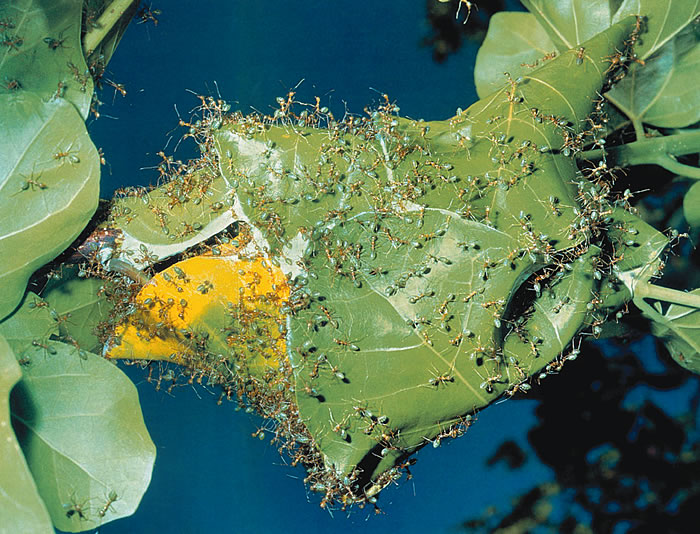 |
| Constructed in the face of external attacks, the nest is sometimes so big as to extend over three trees. The nest is prepared to meet all kinds of situations. It has many departments: from private children rooms to watchtowers. |
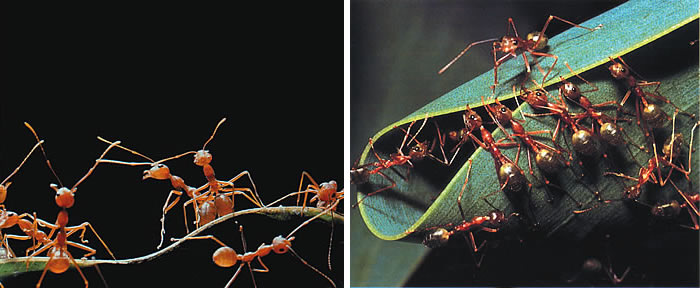 |
| "What is in the heavens and in the earth belongs to Allah. Allah encompasses all things." |
| Firstly, ants disperse over the tree on which they plan to settle (see left). After determining the location where they will build a nest, they immediately set to work. They fold the leaves they will use from the sides. In order to bring the leaves together, they make suspension bridges by clamping them together (see right and below). The ant at the head of the chain holds the leaf at its tip and passes it to the second ant clamping on it. This transfer process goes on until the leaf tip reaches the last ant and the two leaves lap over one another. |
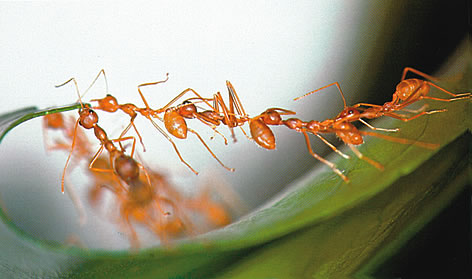 |
 |
Can a larva make a sewing machine? |
| While a few ants hold the tips of leaves with their feet and mouths, the others bring half-developed larvae from the brooding nest. The larvae, with their saliva, function as a shuttle. When the adult ants suppress the larvae on the leave tips, the secretory glands of the larvae, which produce thread, start to work. The ants bring the larvae back and forth like needles until the leaves are attached to each other tightly. (see above) |